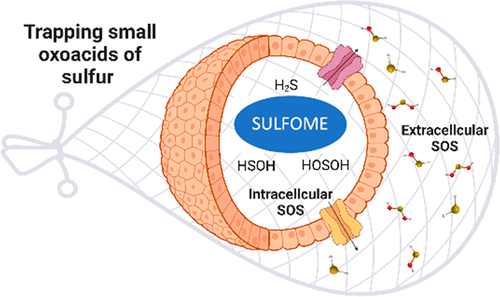当前位置:
X-MOL 学术
›
ACS Chem. Biol.
›
论文详情
Our official English website, www.x-mol.net, welcomes your feedback! (Note: you will need to create a separate account there.)
Characterization of Endogenous and Extruded H2S and Small Oxoacids of Sulfur (SOS) in Cell Cultures
ACS Chemical Biology ( IF 4 ) Pub Date : 2021-08-10 , DOI: 10.1021/acschembio.1c00257 Ottis Scrivner 1 , Murugaeson R Kumar 1 , Kristina Sorokolet 1 , Angelo Wong 2 , Bessie Kebaara 2 , Patrick J Farmer 1
ACS Chemical Biology ( IF 4 ) Pub Date : 2021-08-10 , DOI: 10.1021/acschembio.1c00257 Ottis Scrivner 1 , Murugaeson R Kumar 1 , Kristina Sorokolet 1 , Angelo Wong 2 , Bessie Kebaara 2 , Patrick J Farmer 1
Affiliation

|
This report characterizes and quantifies endogenous hydrogen sulfide (H2S) and small oxoacids of sulfur (SOS = HOSH, HOSOH) in a panel of cell lines including human cancer (A375 melanoma cells, HeLa cervical cells) and noncancer (HEK293 embryonic kidney cells), as well as E. coli DH5α and S. cerevisiae S288C. The methodology used is a translation of well-studied nucleophilic and electrophilic traps for cysteine and oxidized cysteines residues to target small molecular weight sulfur species; mass spectrometric analysis allows for species quantification. The observed intracellular concentrations of H2S and SOS vary in different cell types, from nanomolar to femtomolar, typically with H2S > HOSOH > HOSH. We propose the term sulfome, a subset of the metabolome, describing the nonproteinaceous metabolites of H2S; the sulfomic index is as a measure of the S-oxide redox status, which gives a profile of endogenous sulfur at different oxidation states. An important observation is that H2S and SOS were found to be continuously extruded into surrounding media against a concentration gradient, implying an active efflux process. Small molecule inhibition of several H2S generating enzymes suggest that SOS are not derived solely from H2S oxidation. Even after successful inhibition of H2S production, cells maintain constant efflux and repopulate H2S and SOS over time. This work proves that these small sulfur oxoacids are generated in cells of all types, and their efflux implies that they play a role in cell signaling and possibly other vascular physiology attributed to H2S.
中文翻译:

细胞培养物中内源性和挤压 H2S 和硫的小含氧酸 (SOS) 的表征
本报告描述并量化了一组细胞系中的内源性硫化氢 (H 2 S) 和硫的小含氧酸 (SOS = HOSH, HOSOH),包括人类癌症(A375 黑色素瘤细胞、HeLa 宫颈细胞)和非癌症(HEK293 胚胎肾细胞) ),以及大肠杆菌DH5α和酿酒酵母S288C。所使用的方法是将经过充分研究的半胱氨酸和氧化半胱氨酸残基的亲核和亲电陷阱转化为靶向小分子量硫物质;质谱分析允许物种量化。观察到的 H 2 S 和 SOS 的细胞内浓度在不同的细胞类型中有所不同,从纳摩尔到飞摩尔,通常与 H 2S > HOSOH > HOSH。我们提出了亚砜这个术语,它是代谢组的一个子集,描述了 H 2 S 的非蛋白质代谢物;磺化指数是衡量硫氧化物氧化还原状态的指标,它给出了不同氧化态的内源性硫的概况。一个重要的观察结果是发现 H 2 S 和 SOS 逆着浓度梯度连续挤出到周围介质中,这意味着主动外排过程。几种 H 2 S 生成酶的小分子抑制表明 SOS 并非仅源自 H 2 S 氧化。即使在成功抑制 H 2 S 产生后,细胞仍保持恒定的流出并重新填充 H 2S 和 SOS 随着时间的推移。这项工作证明这些小的硫含氧酸在所有类型的细胞中产生,它们的流出意味着它们在细胞信号传导和可能归因于 H 2 S的其他血管生理学中发挥作用。
更新日期:2021-08-20
中文翻译:

细胞培养物中内源性和挤压 H2S 和硫的小含氧酸 (SOS) 的表征
本报告描述并量化了一组细胞系中的内源性硫化氢 (H 2 S) 和硫的小含氧酸 (SOS = HOSH, HOSOH),包括人类癌症(A375 黑色素瘤细胞、HeLa 宫颈细胞)和非癌症(HEK293 胚胎肾细胞) ),以及大肠杆菌DH5α和酿酒酵母S288C。所使用的方法是将经过充分研究的半胱氨酸和氧化半胱氨酸残基的亲核和亲电陷阱转化为靶向小分子量硫物质;质谱分析允许物种量化。观察到的 H 2 S 和 SOS 的细胞内浓度在不同的细胞类型中有所不同,从纳摩尔到飞摩尔,通常与 H 2S > HOSOH > HOSH。我们提出了亚砜这个术语,它是代谢组的一个子集,描述了 H 2 S 的非蛋白质代谢物;磺化指数是衡量硫氧化物氧化还原状态的指标,它给出了不同氧化态的内源性硫的概况。一个重要的观察结果是发现 H 2 S 和 SOS 逆着浓度梯度连续挤出到周围介质中,这意味着主动外排过程。几种 H 2 S 生成酶的小分子抑制表明 SOS 并非仅源自 H 2 S 氧化。即使在成功抑制 H 2 S 产生后,细胞仍保持恒定的流出并重新填充 H 2S 和 SOS 随着时间的推移。这项工作证明这些小的硫含氧酸在所有类型的细胞中产生,它们的流出意味着它们在细胞信号传导和可能归因于 H 2 S的其他血管生理学中发挥作用。



























 京公网安备 11010802027423号
京公网安备 11010802027423号